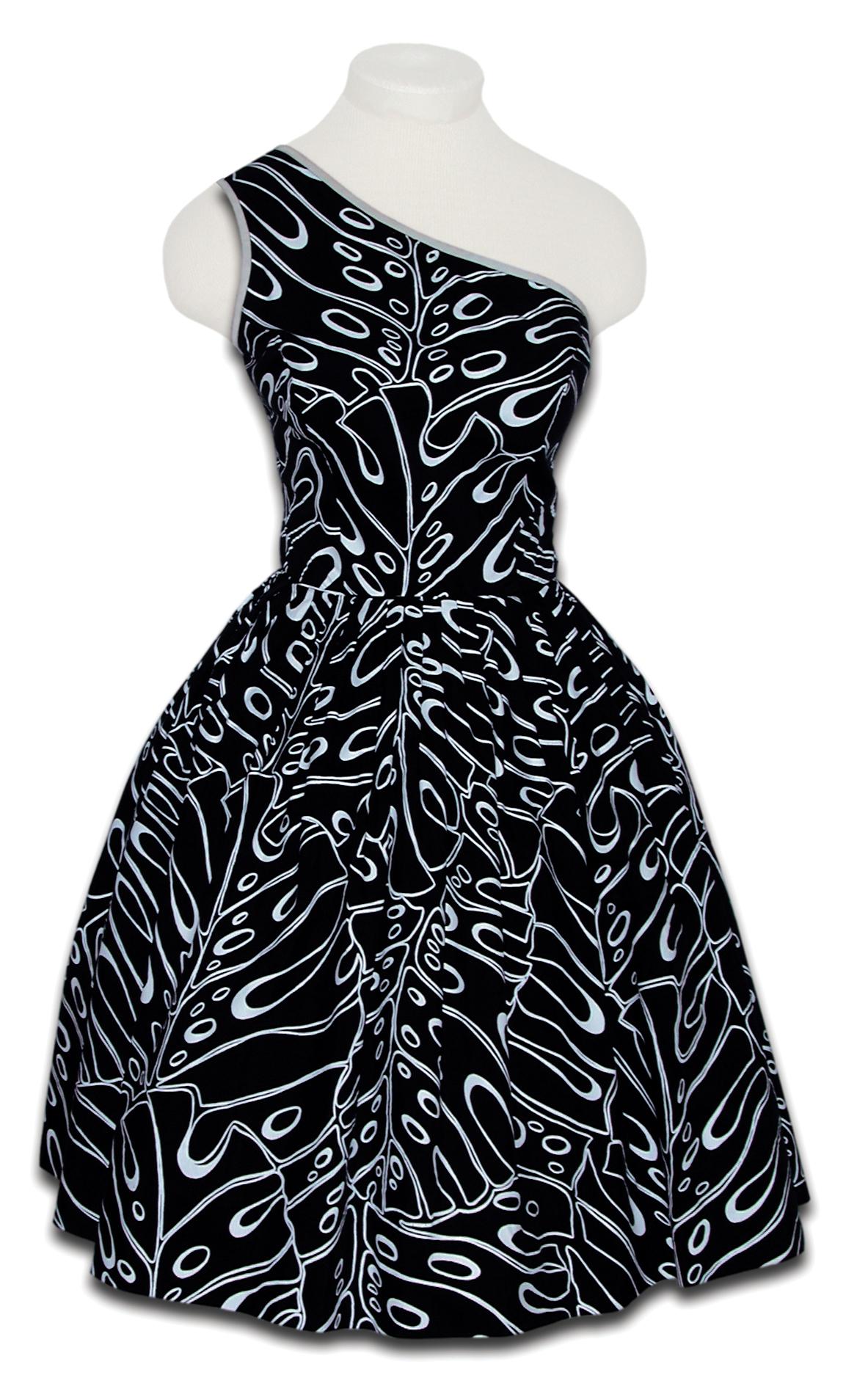Alfred Shaheen is arguably the father of the Hawaiian fashion industry. It was Shaheen who brought Hawai‘i fashion to the world. His unique and artful prints and sophisticated, fashion-forward silhouettes brought national, and even international, attention to island fashion from the 1940s through the 1980s. It was Shaheen who took aloha attire from casual tourist wear to elegant style statements.
Shaheen’s designs were featured in the pages of fashion magazines such as Vogue and Harper’s Bazaar. His clothes were sold all over the world, including Bergdorf Goodman, Bloomingdale’s, and Bullock’s. Elvis Presley famously wore Shaheen’s “Tiare Tapa” print in publicity photos for his 1961 film, Blue Hawaii.
An exhibition this winter at the Bishop Museum, and supported by the Hawai‘i Council for the Humanities, showcased 220 pieces from Shaheen’s collection: dresses, aloha shirts, mu‘umu‘u, swimsuits and cover-ups, fabrics and textile art. In addition, there were dozens of vintage photographs, advertisements, hangtags, buttons, even patterns, which all added up to a brilliant picture of what this innovator meant to the fashion industry in the Islands and abroad.
“HI Fashion: The Legacy of Alfred Shaheen” was a joint effort of the Bishop Museum and Camille Shaheen-Tunberg (daughter of Alfred Shaheen) and her husband, William Tunberg. It was cocurated by Betty Kam, Bishop Museum’s director of cultural collections, and Camille Shaheen-Tunberg. The exhibit showed how Shaheen captivated clothing connoisseurs for decades: His prints and silhouettes look modern and sophisticated even today.
Archival photos told the story of the man, his company, his textile artists, and fashion designers. Shaheen (1922–2008) grew up in the fashion industry. His grandfather, who came to the United States from Lebanon, established silk factories in New York and New Jersey. His parents, George and Mary Shaheen, moved their business to Hawai‘i in 1938. Mary opened her own custom clothing shop called Margo’s.
After attending Whittier College and serving as a fighter pilot during WWII, in 1948, with the help of his mother, he established Shaheen’s of Honolulu and Surf ‘n Sand. Although it is often a costly endeavor to manufacture in Hawai‘i, the most isolated chain of islands in the world, Shaheen was committed to doing so. He managed to keep his entire vertical operation in Honolulu, from large-scale screen printing to manufacture and distribution. An avid inventor, Shaheen engineered and constructed his own machinery to print, dye, and finish his fabrics. In 1950, he opened the 7,500 square foot Surf ‘n Sand Hand Prints factory near Waikiki. Two years later, the factory was printing 60,000 yards of fabric per month. By 1958, he had established a chain of a dozen retail stores and the company posted $4 million in sales.
Always the innovator, Shaheen pioneered the engineered print, a silk screen design that was coordinated with the silhouette from the earliest design stages so the print and style created a stunning garment. He built his own 24-inch silk screens in order to produce large design motifs. He developed metallic dyes, in about one hundred colors, that were washable, and became a signature for the company.
Another signature was the company’s sexy sundresses, engineered to flatter the figure. The construction is complex and combines the best of the 1950s aesthetic with modern materials. One of the most popular designs was the Shaheen sheath, a flattering sundress that could easily convert to a sexy, off-the-shoulder look.
Shaheen originated the pop-up shop concept by creating “East Meets West” store-within-a-store boutiques. These pre-fabricated, self-contained units could be shipped all across the United States and assembled inside major department stores. In the 1960s, immediately following Hawaiian statehood, the company diversified, adding footwear, drapery, jewelry, fragrance, even pattern kits complete with fabric and coconut buttons.
By the end of the 1950s, Shaheen employed more than four hundred people in Honolulu. Among his employees were four artists. He provided them with their own studio and taught them the nuances of textile design. They created more than 6,000 designs between 1948 and 1988.
Textile scholar Linda Arthur Bradley, professor and curator of the Department of Apparel, merchandising, Design and Textiles at Washington State University, quotes Shaheen in the exhibit catalog: “Basically what I wanted them (the artists) to do was to create a textile design that had some meaning to it, to write a story about each textile design. We tried to put more substance into the design, and on the hangtag we’d write the story behind the design.”
Shaheen sent his textile artists to the Bishop Museum to study Polynesian bark cloth, also known as kapa or tapa. This sparked worldwide interest in Hawaiian and Asian motifs. Based on this success, Shaheen sent his artists abroad, throughout Asia and the Pacific, to search new and exciting design inspirations.
“Fusion Fashion,” as Shaheen’s designs were described, came to represent the multiethnic nature of the Islands’ residents: Chinese, Japanese, Polynesian, Filipino, and others. Many of his textile designs originated with a cultural icon such as the Japanese kokeshi doll, Chinese chopsticks, and Hawaiian feathered kahili. His silhouettes were also culturally inspired. His “Pake Mu‘u” was a nod to the Chinese cheongsam, “Asian Blossom” was inspired by the Japanese kimono, and “Tahitian Girl” was influenced by the pareu.
The design team at Shaheen captured the essence of the Hawaiian Islands with every textile design and silhouette produced in forty-plus years in fashion. They weaved into every garment the cultural diversity and exotic nature of the unique place they called home.






